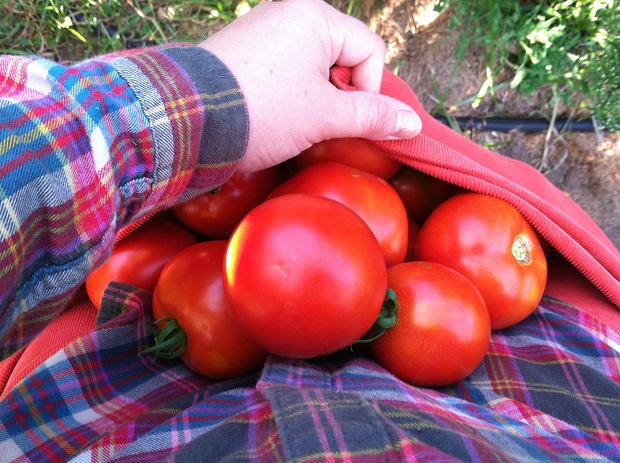A lot of parameters were considered with the harvests. Weights of marketable and unmarketable fruit, counts of marketable and unmarketable fruit, and the percentage of the harvest that was unmarketable, which I calculated based on weight. In the context of breeding for flavor, there are many advocates who de-prioritize yield. Unfortunately, from a grower’s point of view, yield has to remain a priority in order to remain competitive in the market. Additionally, many tout lower yields in organic systems as a reason to continue industrial agricultural practices. Part of NOVIC’s founding principles involve breeding in organic systems as a means of mitigating these yield differences thereby encouraging adoption of organic practices and organic incentivizing policies. I’m taking the easy way out and copy-and-pasting excerpts from my formal paper analyzing the harvest parameters. A couple of takeaways for me though: plum types and determinate types were more productive. Surprising considering the reliance on indeterminate types by the majority of farmer’s I know. The trade-off seems to be timing. Indeterminate varieties ripened earlier and therefore gave less fruit, but produced over a longer period of time.
Significant differences were detected between marketable yields (grams per plant) of varieties with a standard ANOVA (F10,44 = 4.09, p < .001), but data did require transformation with Excel’s sqrt() function in order to achieve normal distribution. In follow-up analysis with Tukey’s HSD, pairwise differences were examined. The connecting letters report shows each variety shares a letter with at least 7 other varieties, but Mountain Merit, Plum Regal, and OSU S200 were the top three producers in terms of total marketable fruit mass. Matina, as the only salad type, produced the least amount of weight. However, growers and researchers thought both Matina and Damsel produced the most fruit in the weeks before and after the five weeks of trial harvests.
| Variety | Total Marketable Yield (g/plant) | Connecting Letters | Rank |
|---|---|---|---|
| (K) Mt. Merit | 3181 | a | 1 |
| (B) OSU S200 | 2968.33 | ab | 2 |
| (I) Plum Regal | 2676.5 | ab | 3 |
| (E) Plum Perfect | 2249.67 | abc | 4 |
| (G) Damsel | 2202.83 | abc | 5 |
| (E) Estate | 1813.33 | abc | 6 |
| (A) Home Stoop | 1568.5 | abc | 7 |
| (J) OSU LB8-7 | 1456.17 | abc | 8 |
| (C) Stellar | 1252 | bc | 9 |
| (H) Crimson Sprinter | 1176.5 | bc | 10 |
| (D) Matina | 745 | c | 11 |
ANOVA revealed significant differences for total fruit count (F10,44 = 5.68, p < .001) and marketable fruit count (F10,44 = 6.37, p < .001), but these two parameters grouped almost identically in Tukey’s post-hoc analysis. Analysis of total and marketable fruit counts also required sqrt() transformations due to the nature of count data. In the connecting letters report for both total and marketable fruit counts, each variety shared a letter with at least 5 others. The plum types (Plum Perfect, Plum Regal, and OSU LB8-7) along with OSU S200 showed to be the top performers, and, except for Stellar, the determinate varieties produced more fruit than the indeterminate varieties.
| Variety | Total Marketable Fruit Count (per plant) | Connecting Letters | Rank |
|---|---|---|---|
| (I) Plum Regal | 26 | a | 1 |
| (J) OSU LB8-7 | 25 | ab | 2 |
| (B) OSU S200 | 23.84 | abc | 3 |
| (F) Plum Perfect | 22.33 | abc | 4 |
| (D) Matina | 16.17 | abcd | 5 |
| (K) Mt. Merit | 14.66 | abcd | 6 |
| (G) Damsel | 12.01 | bcd | 7 |
| (C) Stellar | 11.33 | cd | 8 |
| (H) Crimson Sprinter | 10.33 | cd | 9 |
| (E) Estate | 8.33 | d | 10 |
| (A) Home Stoop | 8 | d | 11 |
Arcsine transformations were attempted on proportionally expressed data for the percentage of the harvest deemed unusable. Acceptable normality for ANOVA could not be achieved with these most typical transformations, so the lesser used logit transformation was used with aid of a table available from MedCalc (1993). With normality expectations met, ANOVA revealed significant differences between varieties (F10,44 = 3.21, p = .004) for percentage of harvest considered unmarketable. Tukey’s post-hoc analysis showed each variety sharing a letter with at least eight others in the connecting letters report. Mountain Merit and Plum Perfect appear to be front-runners with the lowest percentage of unmarketable fruit, whereas Stellar and Home Stoop seem to be the worst.
| Variety | Average Percent Unusable | Connecting Letters | Rank |
|---|---|---|---|
| (K) Mt. Merit | 16% | a | 1 |
| (F) Plum Perfect | 16% | ab | 1 |
| (I) Plum Regal | 17% | abc | 3 |
| (E) Estate | 22% | abc | 4 |
| (H) Crimson Sprinter | 24% | abc | 5 |
| (J) OSU LB8-7 | 25% | abc | 6 |
| (D) Matina | 28% | abc | 7 |
| (G) Damsel | 29% | abc | 8 |
| (B) OSU S200 | 29% | abc | 8 |
| (C) Stellar | 35% | bc | 10 |
| (A) Home Stoop | 37% | c | 11 |

Leave a Reply